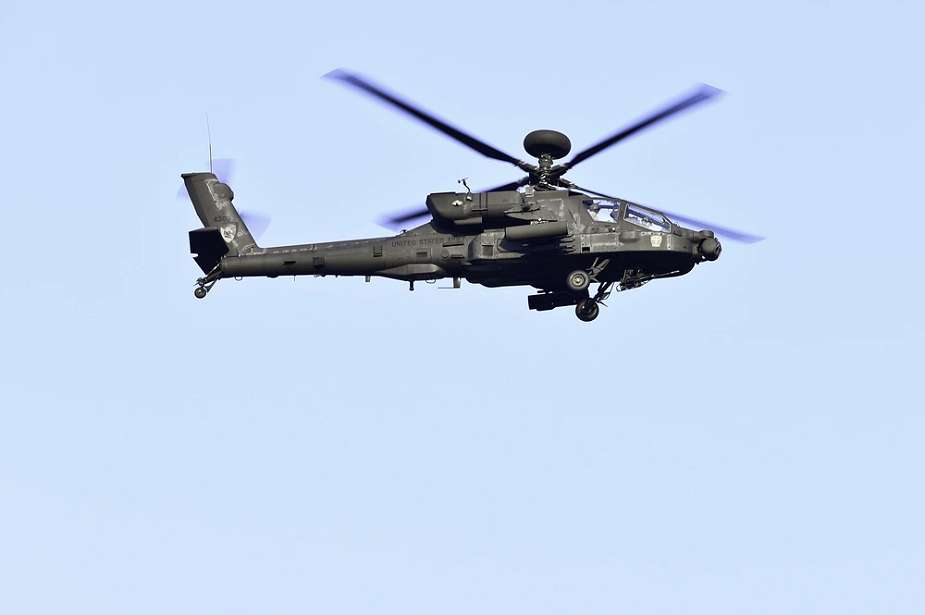Breaking news
Ukraine Requests US AH-64 Apache Helicopters to Counter Russian Tank Forces.
Ukraine has recently requested new military equipment, including the formidable American-made AH-64 Apache helicopter, renowned for its anti-tank prowess. This request underscores Ukraine's acute awareness of the need to enhance its anti-armor capabilities in the face of the heavily armored Russian forces currently deployed in Ukraine.
Follow Army Recognition on Google News at this link

The American AH-64 Apache is considered as one of the best anti-tank attack helicopters able to fire AGM-114 Hellfire missiles. (Picture source U.S. DoD)
At the heart of this development is the AH-64 Apache's formidable reputation, honed over the past 20 years in various global conflicts. Its deployment in the Middle East, particularly for anti-armor operations, has demonstrated its effectiveness in combat scenarios. These helicopters come equipped with advanced targeting systems and agility, enabling them to effectively counter heavy armored units like those employed by Russian forces. For Ukraine, the introduction of such a powerful asset could provide a significant edge, enhancing their surveillance and attack capabilities across the diverse terrains of the conflict zone.
However, integrating these sophisticated helicopters into Ukraine's military arsenal is not without challenges. Key among these is the need for specialized training for pilots and maintenance crews, a process that requires time and resources. Additionally, the logistical demands for maintaining these helicopters, including a steady supply of parts and ammunition, are substantial. These operational challenges have been evident in past deployments of AH-64s in conflicts such as Afghanistan and Iraq, where logistical support and vulnerability to ground fire posed significant hurdles.
The potential escalation of Western military support through the provision of AH-64s also raises critical geopolitical concerns. This move could be perceived as a significant escalation by Russia, potentially prompting a more severe response and complicating diplomatic efforts to resolve the conflict. The decision to supply these helicopters must therefore be weighed carefully against the broader context of international relations and the risks of exacerbating the conflict.
Moreover, the introduction of AH-64s into the Ukrainian conflict is not just about immediate military outcomes but also about setting precedents for future engagements and altering regional security dynamics. The long-term impact of such a deployment extends beyond the battlefield, potentially influencing Ukraine's military capabilities and strategies in the current conflict.
Ukraine's request for AH-64 Apache helicopters is a critical development in the ongoing conflict with Russia. While offering considerable tactical advantages, it brings with it a host of challenges and broader implications. The experience of these helicopters in other conflicts provides valuable insights, yet the unique circumstances of the Ukraine conflict demand a nuanced approach to their deployment. This situation underscores the complex interplay of military strategy, logistical planning, and international diplomacy in modern warfare.

The AH-64E Apache is the latest variant of Apache attack helicopters in service with the U.S. armed forces. (Picture source U.S. DoD)
The latest version of the AH-64 Apache, often referred to as the AH-64E or "Guardian," embodies a significant leap in combat capabilities and armament, making it one of the most advanced attack helicopters in service. The AH-64E features state-of-the-art avionics and sensors, including the Longbow fire control radar. This radar system represents a substantial improvement in target acquisition and engagement, enabling the helicopter to detect, track, and prioritize multiple targets, a crucial ability in high-threat environments.
Additionally, the AH-64E is equipped with enhanced digital connectivity, allowing for better communication and data sharing with other platforms. This network-centric warfare capability ensures that the Apache can function as part of a coordinated military effort, sharing and receiving information with ground forces, drones, and other aircraft. This level of integration is vital for modern combat operations where situational awareness and rapid response are key.
In terms of armament, the AH-64E carries a formidable array of weapons. The primary armament is the M230 chain gun, a 30mm automatic cannon capable of firing a variety of ammunition types, tailored for different targets. For anti-armor purposes, the Apache can be equipped with AGM-114 Hellfire missiles. These missiles are highly effective against armored vehicles, bunkers, and fortified positions. Additionally, the helicopter can carry Hydra 70 rocket pods for use against softer targets or for suppression fire.
The Guardian’s improved performance features include more powerful engines and advanced flight control systems. These enhancements provide greater agility and speed, making the helicopter more maneuverable in combat situations. The improved engines also allow for better performance at high altitudes and in hot conditions, extending the operational range and capabilities of the Apache in diverse environments.
In conclusion, the AH-64E Apache "Guardian" represents the pinnacle of attack helicopter design. With advanced targeting systems, enhanced digital connectivity, a powerful array of weapons, and improved performance characteristics, it is well-suited for the complexities of modern warfare. Its capabilities make it a highly valuable asset for any military operation, particularly in scenarios involving tank and armored vehicle engagements.
Defense News January 2024


























